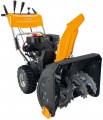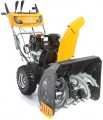Design
—
Self-propelled design. In self-propelled snow blowers, the built-in motor drives not only the auger, but also the wheels / tracks, ensuring the movement of the device. In this way, you do not have to push the snow blower by hand, which makes work much easier — especially with heavy, powerful models. Most self-propelled models have a transmission that allows you to adjust the speed of movement, as well as the ability to move backward (see "Number of gears").
—
Overload protection. A safety system that protects the unit from breakdowns in the event of critical loads. The main reason for the occurrence of such loads is the jamming of the screw — for example, due to the ingress of a foreign object. Therefore, most often, special bolts are used for protection, connecting the auger to the motor gearbox: with a sharp increase in load, the bolts are cut off and the auger is disconnected from the gearbox. Another option is overheating protection that reacts to engine temperature; it is found predominantly in electrical assemblies and can be used alone or in combination with shear bolts.
—
Headlights. The presence of a headlight (headlights) in the design of the snow blower allows you to use it for work at night, when there are no other light sources or they are not enough. In addition, in some models, the headlights turn on automatically every time the engine is starte
...d — they play the role of a warning signal that the unit is running.
— Heated handles. Heating system for handles, which the operator holds during work. This feature is especially useful as snow blowers are used in cold weather, and hands can get cold during prolonged use. On the other hand, with small volumes of cleaning, you can completely do with gloves, so heated handles are found mainly in powerful models with internal combustion engines, designed for large volumes of work.Motor type
Model of the engine installed in the snow blower.
With this information, you can find detailed data on the engine — from official specifications to reviews, reviews and advice on specific nuances. In this way, you can evaluate how a snow blower with this particular engine will suit your needs.
Motor power
Snowblower motor power in horsepower.
The universal unit of power today is watts, but for petrol and diesel engines (see "Motor type"), the traditional designation in horsepower may also be given. 1 HP approximately equal to 735 watts.
The higher the motor power, the higher the performance of the snow blower, the better it handles with high dense snowdrifts and icy crust. However, more powerful engines consume more fuel, weigh more and cost more, and their use is not always justified. Detailed recommendations on choosing the optimal power for a specific situation can be found in special sources.
Fuel tank volume
The amount of fuel that the snow blower tank can hold at one time. Knowing this figure, as well as fuel consumption (see above), you can easily calculate the approximate operating time on one gas station. However, manufacturers usually choose the volume so that the operating time reaches at least 2 – 2.5 hours, so in most cases you can not pay much attention to this parameter.

